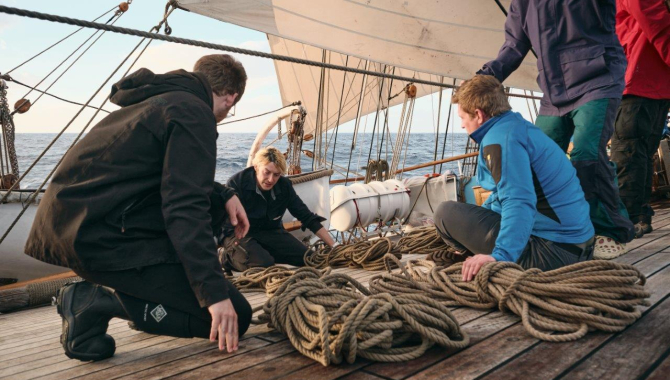Sailing the Southeasterlies off the African coast

Steep seas, ocean currents. The Art of Nature or the Nature of Art.
Beginning with the depths of space and the regions of remotest nebulae, we will gradually descend through the starry zone to which our solar system belongs, to our own terrestrial spheroid, circled by air and ocean, there to direct our attention to its form, temperature, and magnetic tension, and to consider the fullness of organic life unfolding itself upon its surface beneath the vivifying influence of light. In this manner, a picture of the world may, with a few strokes, be made to include the realms of infinity no less than the minute microscopic animal and vegetable organisms which exist in standing waters and on the weather beaten surface of our rocks.
- Alexander van Humboldt. Cosmos. 1849
The energy from the sun heats the atmosphere at the equatorial latitudes. The poles receive less of it. That triggers a general system of rising and falling air masses producing belts of High or Low Atmospheric Pressure around the Earth at different latitudes, which at the time drive the main wind patterns worldwide. Wind, gravity, temperature, and salinity make for the oceans to be always in motion.
In the Southern Hemisphere, the Subtropical High Pressures drive the tireless Southeasterly winds that we ride already since days. In the ocean, the east-flowing current flows northwards along the African coast in an intense flow that produces part of the leeway that we are experiencing. Effects from the rotation of our planet, combined with this so-called Benguela Current, produce upwelling of deep waters along the shoreline; loaded with nutrients, they represent the base for a rich and diverse marine ecosystem that brings a large-scale fishery.
From the Indian Ocean, one of the world’s most intense water flows meets the Atlantic circulation and turns back, creating an unsettled area with eddies that get detached and free roam towards the middle of the ocean.
In the region where we are sailing, the wind steadily blows from the Southeast, Benguela flows north, and Agulhas creates turbulent interactions with it. The result is a steep sea, high short waves driven by the winds and interacting with the different directions of the ocean motion. Here, the ship heels to Portside now and then, dipping her caprail in the water, though she sails well and fast. Aloft, squares are set up to the Topsails, Lower Staysails, Spanker, and three sails in the headrig, however, when the wind picks up at sunrise and squalls pass by, we reduce sail. Then the powerful Outer jib comes down and the large Desmond over the main deck is replaced by the smaller Aap. Sails that see the light again out of their furls in the afternoon when the conditions slightly abate. But continuing with the ups and downs, it blows harder again later in the afternoon. Once more, Outer Jib is stowed away.
The nature of the atmosphere and the ocean, the origins of their characteristics, their interactions, the sailing conditions, and the work with the sails. All can be interpreted as separate items or instead at a level of interconnectivity that helps us to find our way, route our trip, and understand the world that surrounds us.
Technology comes in handy here. It has helped in the collection of data, its study, and its interpretation. For instance, for the sailors, it has allowed them to create maps to interpret weather and currents. Those can be shown as an array of colour patterns related to different variables, such as the speed of the flows of both air and wind. The result can be seen and read as elaborate designs of Nature, their plotting and printing a bridge between scientific data and an artistic manifestation.
Alexander van Humboldt, the father of disciplines such as Ecology and Biogeography, succeeded in creating school around the idea of a unifying field of the natural phenomena, a universal view of nature. But he didn’t stop here, he wrote about the bond between science and art.
May the immeasurable diversity of phenomena which crowd into the picture of nature in no way detract from that harmonious impression of rest and unity which is the ultimate object of every literary or purely artistically composition.
Alexander van Humboldt. Cosmos. 1849
A view that has impacted our appreciation of nature since. And the man who continued developing these ideas and brought Humboldt’s concept of Art, Ecology and Nature into the twentieth century was Ernst Haeckel, a man who influenced artists and scientists alike,
Predilection for the study of nature and for industrial progress should be complemented with arts by which life is embellished by the vivifying breath of imagination.
Andrea Wulf. The Invention of Nature.




